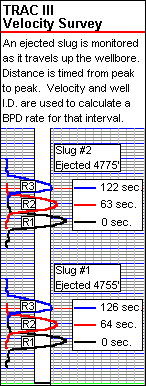

The velocity survey method is different than that run on an injection well. We do not shoot stationary velocity shots. We eject a slug of radioactive material into the flow and pull the detector up through the slug while recording the results on depth drive. As the slug continues to travel up hole, the detector is lowered and the pull on depth drive is repeated. Recording the travel times from peak to peak gives us the data to calculate a rate in barrels per day for that section of the wellbore. This procedure is repeated in strategic locations throughout the well to calculate a producing profile.
This modified velocity profile is used to minimize the effects of multi-phase flow, fluid surges under a rod pump, and the fluid surges associated with flowing wells. Stationary velocity shots are often inconclusive in a producing environment.
The following are some sample calculations for our example. Slug #1 was ejected at 4755 feet and has moved up to approximately 4752 feet on our first logging pass. This is our zero time point. Run 2 indicates that the slug traveled up hole 12 feet in 64 seconds.
| Subject | Formula | Cubic Inches | Cu. In./BBL | BBLS/12' |
|---|---|---|---|---|
| Casing | 3.14 x (4.950"/2)² x 144" = | 2,769.76 | 10,164 | .2725 |
| (86,400 secs/day / Reaction Time sec) x V bbls = BBLS/DAY |
|---|
| (86,400 / 64) x .2725 = 367.86 BBLS/DAY |
Slug #1, R1 to R2 indicates a 64 second reaction time over 12' which equates to 367.86 BBLS/Day
See a movie: How to calculate tracer velocities!
| Subject | Formula | Cubic Inches | Cu. In./BBL | BBLS/11' |
|---|---|---|---|---|
| Casing | 3.14 x (4.950"/2)² x 132" = | 2,538.95 | 10,164 | .2498 |
| (86,400 secs/day / Reaction Time sec) x V bbls = BBLS/DAY |
|---|
| (86,400 / 62) x .2498 = 348.12 BBLS/DAY |
Slug #1, R2 to R3 indicates a 62 second reaction time over 11' which equates to 348.12 BBLS/Day
| Slug #1, R1 - R2 | Slug #1, R2 - R3 | Average Rate |
|---|---|---|
| 367.86 | 348.12 | 357.99 |
We can now calculate the average rate from 4752' to 4729' as 358 BPD. This gives us a point to compare and calculate rate differentials throughout the wellbore in order to determine points of entry and the volumes of those entries. One word of caution. The above calculations are based on the assumption of a clean and consistent internal diameter of 4.95 inches. However, we all know that is rarely the case. Take a look at the calculations on our caliper page. I believe you will be surprised at how much error can be avoided by knowing the internal diameter and general condition of the wellbore at the time of logging.
Annulus TRAC-III Page
Flowing TRAC-III Page
Cardinal Welcome Page
